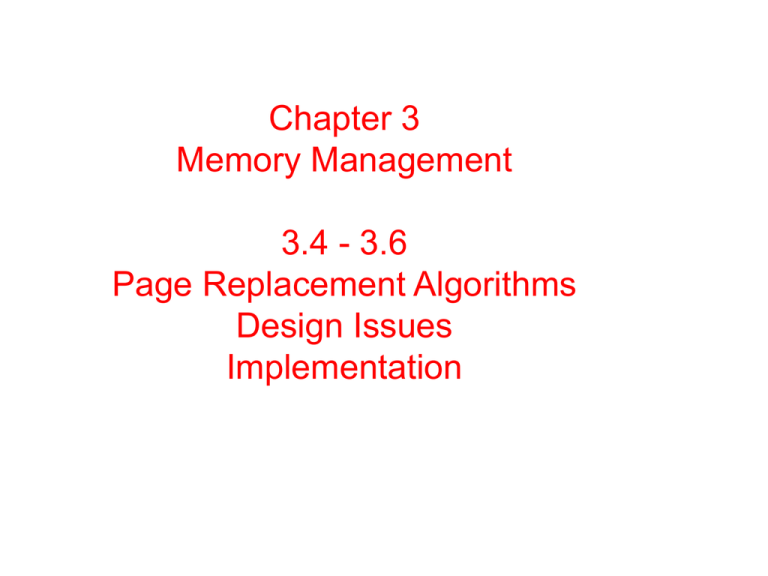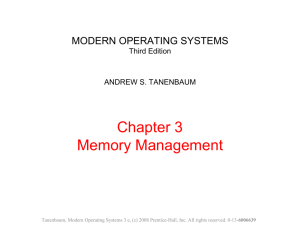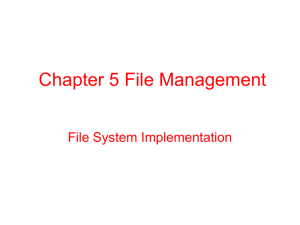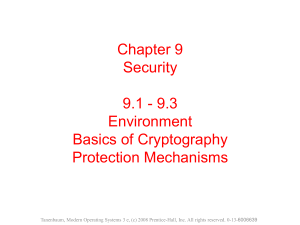
Chapter 3
Memory Management
3.4 - 3.6
Page Replacement Algorithms
Design Issues
Implementation
Page Replacement Algorithms
•
•
•
•
•
•
•
•
Optimal page replacement algorithm
Not recently used page replacement
First-In, First-Out page replacement
Second chance page replacement
Clock page replacement
Least recently used page replacement
Working set page replacement
WSClock page replacement
Tanenbaum, Modern Operating Systems 3 e, (c) 2008 Prentice-Hall, Inc. All rights reserved. 0-13-6006639
Second Chance Algorithm
Figure 3-15. Operation of second chance.
(a) Pages sorted in FIFO order.
(b) Page list if a page fault occurs at time 20 and A has its R bit
set. The numbers above the pages are their load times.
Tanenbaum, Modern Operating Systems 3 e, (c) 2008 Prentice-Hall, Inc. All rights reserved. 0-13-6006639
The Clock Page Replacement Algorithm
Figure 3-16. The clock page replacement algorithm.
Tanenbaum, Modern Operating Systems 3 e, (c) 2008 Prentice-Hall, Inc. All rights reserved. 0-13-6006639
LRU Page Replacement Algorithm
Figure 3-17. LRU using a matrix when pages are referenced in the
order 0, 1, 2, 3, 2, 1, 0, 3, 2, 3.
Tanenbaum, Modern Operating Systems 3 e, (c) 2008 Prentice-Hall, Inc. All rights reserved. 0-13-6006639
Simulating LRU in Software
Figure 3-18. The aging algorithm simulates LRU in software. Shown
are six pages for five clock ticks. The five clock ticks are
represented by (a) to (e).
Tanenbaum, Modern Operating Systems 3 e, (c) 2008 Prentice-Hall, Inc. All rights reserved. 0-13-6006639
Working Set Page Replacement (1)
Figure 3-19. The working set is the set of pages used by the k most
recent memory references. The function w(k, t) is the size of the
working set at time t.
Tanenbaum, Modern Operating Systems 3 e, (c) 2008 Prentice-Hall, Inc. All rights reserved. 0-13-6006639
Working Set Page Replacement (2)
Figure 3-20. The working set algorithm.
Tanenbaum, Modern Operating Systems 3 e, (c) 2008 Prentice-Hall, Inc. All rights reserved. 0-13-6006639
The WSClock Page Replacement Algorithm (1)
When the hand comes all the way around to its
starting point there are two cases to consider:
•
•
At least one write has been scheduled.
No writes have been scheduled.
Tanenbaum, Modern Operating Systems 3 e, (c) 2008 Prentice-Hall, Inc. All rights reserved. 0-13-6006639
The WSClock Page Replacement Algorithm (2)
Figure 3-21. Operation of the WSClock algorithm. (a) and (b) give an
example of what happens when R = 1.
Tanenbaum, Modern Operating Systems 3 e, (c) 2008 Prentice-Hall, Inc. All rights reserved. 0-13-6006639
The WSClock Page Replacement Algorithm (3)
Figure 3-21. Operation of the WSClock algorithm.
(c) and (d) give an example of R = 0.
Tanenbaum, Modern Operating Systems 3 e, (c) 2008 Prentice-Hall, Inc. All rights reserved. 0-13-6006639
Summary of Page Replacement Algorithms
Figure 3-22. Page replacement algorithms discussed in the text.
Tanenbaum, Modern Operating Systems 3 e, (c) 2008 Prentice-Hall, Inc. All rights reserved. 0-13-6006639
Local versus Global Allocation Policies (1)
Figure 3-23. Local versus global page replacement.
(a) Original configuration. (b) Local page replacement.
(c) Global page replacement.
Tanenbaum, Modern Operating Systems 3 e, (c) 2008 Prentice-Hall, Inc. All rights reserved. 0-13-6006639
Local versus Global Allocation Policies (2)
Figure 3-24. Page fault rate as a function
of the number of page frames assigned.
Tanenbaum, Modern Operating Systems 3 e, (c) 2008 Prentice-Hall, Inc. All rights reserved. 0-13-6006639
Separate Instruction and Data Spaces
Figure 3-25. (a) One address space.
(b) Separate I and D spaces.
Tanenbaum, Modern Operating Systems 3 e, (c) 2008 Prentice-Hall, Inc. All rights reserved. 0-13-6006639
Shared Pages
Figure 3-26. Two processes sharing the same program
sharing its page table.
Tanenbaum, Modern Operating Systems 3 e, (c) 2008 Prentice-Hall, Inc. All rights reserved. 0-13-6006639
Shared Libraries
Figure 3-27. A shared library being used by two processes.
Tanenbaum, Modern Operating Systems 3 e, (c) 2008 Prentice-Hall, Inc. All rights reserved. 0-13-6006639
Page Fault Handling (1)
•
•
•
•
The hardware traps to the kernel, saving the
program counter on the stack.
An assembly code routine is started to save the
general registers and other volatile information.
The operating system discovers that a page fault
has occurred, and tries to discover which virtual
page is needed.
Once the virtual address that caused the fault is
known, the system checks to see if this address is
valid and the protection consistent with the access
Tanenbaum, Modern Operating Systems 3 e, (c) 2008 Prentice-Hall, Inc. All rights reserved. 0-13-6006639
Page Fault Handling (2)
•
•
•
If the page frame selected is dirty, the page is
scheduled for transfer to the disk, and a context
switch takes place.
When page frame is clean, operating system looks
up the disk address where the needed page is,
schedules a disk operation to bring it in.
When disk interrupt indicates page has arrived,
page tables updated to reflect position, frame
marked as being in normal state.
Tanenbaum, Modern Operating Systems 3 e, (c) 2008 Prentice-Hall, Inc. All rights reserved. 0-13-6006639
Page Fault Handling (3)
•
•
•
Faulting instruction backed up to state it had when
it began and program counter reset to point to that
instruction.
Faulting process scheduled, operating system
returns to the (assembly language) routine that
called it.
This routine reloads registers and other state
information and returns to user space to continue
execution, as if no fault had occurred.
Tanenbaum, Modern Operating Systems 3 e, (c) 2008 Prentice-Hall, Inc. All rights reserved. 0-13-6006639
Instruction Backup
Figure 3-28. An instruction causing a page fault.
Tanenbaum, Modern Operating Systems 3 e, (c) 2008 Prentice-Hall, Inc. All rights reserved. 0-13-6006639
Backing Store (1)
Figure 3-29. (a) Paging to a static swap area.
Tanenbaum, Modern Operating Systems 3 e, (c) 2008 Prentice-Hall, Inc. All rights reserved. 0-13-6006639
Backing Store (2)
Figure 3-29. (b) Backing up pages dynamically.
Tanenbaum, Modern Operating Systems 3 e, (c) 2008 Prentice-Hall, Inc. All rights reserved. 0-13-6006639
Separation of Policy and Mechanism (1)
Memory management system is divided into
three parts:
•
•
•
A low-level MMU handler.
A page fault handler that is part of the kernel.
An external pager running in user space.
Tanenbaum, Modern Operating Systems 3 e, (c) 2008 Prentice-Hall, Inc. All rights reserved. 0-13-6006639
Separation of Policy and Mechanism (2)
Figure 3-30. Page fault handling with an external pager.
Tanenbaum, Modern Operating Systems 3 e, (c) 2008 Prentice-Hall, Inc. All rights reserved. 0-13-6006639









